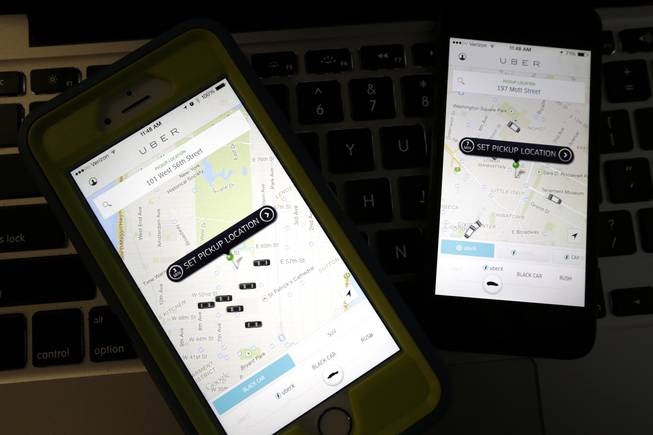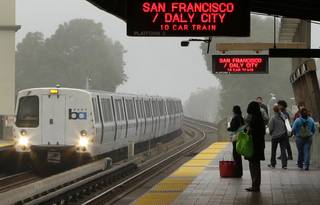
AP Photo/Julio Cortez, File
This Friday, Nov. 21, 2014, photo taken in Newark, N.J., shows smartphones displaying Uber car availability in New York.
Monday, Jan. 18, 2016 | 1:55 a.m.
Related Content
- How does Southern Nevada pay for a new mass transit system?
- Light rail: The future of transportation in Las Vegas?
- How does a plan like this come to be? Who is responsible
- Rail projects in other cities: How’d they do it?
- Getting Southern Nevada’s future on the right track
- How mass transit will affect Southern Nevada business
- How mass transit will affect Southern Nevada tourism
- How mass transit will affect Southern Nevada tourism
- How mass transit will affect downtown Las Vegas
- How mass transit will affect North Las Vegas
- How mass transit will affect sports in Southern Nevada
- How mass transit will affect Southern Nevada’s people and lifestyle
- A local’s take: The evolution of transportation in Las Vegas
- Editorial: Why Southern Nevada needs mass transit
- The Sun's light rail coverage
A look into the future of business: Light rail stations around the valley have become hubs for retail shops and restaurants. Small businesses have moved into the area surrounding the stations. The value of real estate has risen.
Commercial development
Construction jobs morph into permanent retail jobs. Rail stations transform into commercial hubs. These are some of the effects proponents say take place with light rail.
In Southern Nevada, that could mean more development in areas such as downtown and North Las Vegas. Other cities have seen light rail stimulate business development in underserved areas. With it comes jobs.
Take Minneapolis. The city was able to spark development with its Green Line corridor while avoiding gentrification because the city and state governments helped support development of affordable housing.
Small business
In Minneapolis, small businesses started cropping up along the light rail line. A $30 million brewery opened in part because it found a location close to the rail line and close to a bike trail. A facility for seniors expanded and hired 100 workers because demand increased.
Similar changes could take place in Las Vegas. Light rail proponents argue that Las Vegas already loses commerce because of a lack of mobility. “It’s costing us billions by not having light rail,” said Tom Skancke, former head of the Las Vegas Global Economic Alliance.
Skancke recalled a recruiting dinner at New York-New York with businesspeople from Europe. After 45 minutes pitching them on why Las Vegas would be a great city for their company, the executives started complaining about the lack of public transportation connecting McCarran International Airport.
“Why should I move my company here when my employees in Vienna don’t have cars?” a representative asked, according to Skancke.
It’s a question that could be answered if the city had light rail, Skancke said.As has been the case in other cities, light rail also likely would attract small businesses, especially if the stations encouraged the development of housing or shopping.
“Anywhere that creates traffic, businesses spring up,” said Len
Krick, a business broker in Las Vegas. “That’s fact.”
Real estate
A light rail system stands to boost values throughout the community. Studies show that a rail line generally leads to higher property values and rent. How much of an increase depends on a number of factors, including the frequency of the transit service.
And while some research indicates that property values dip before lines become operational, there’s ample evidence pointing to an overall benefit. A recent study of single-family homes in Charlotte, N.C., from 1997 to 2008, for example, found that after a period of mixed effects during construction periods, values rose after completion.
And while there have been concerns that gentrification related to higher property values can displace residents, proponents of light rail say it can help improve substandard housing and lead to beautification if routed through underdeveloped areas.
Ride-hailing
Even in highly developed public transit systems — in New York or Washington, D.C., for example — trains do not always deliver their riders to the exact point they need to be. Sometimes, the commuters need to go farther. That’s where ride-hailing companies such as Uber and Lyft play a role.
Both companies already operate in several markets with public transportation, including in cities with light-rail systems. Lyft, for instance, operates in Los Angeles, San Francisco, Portland, Boston and Dallas, where the startup has a partnership with the area’s public transit agency. Riders of Dallas Area Rapid Transit can access Lyft through a mobile ticketing application and receive $5 off their first 10 Lyft rides.
“If we’re going to stay relevant as a transportation provider, we have to offer options so they can make a complete trip, whether it’s for work or fun,” DART director Gary Thomas said. “Lyft is a great way to help them begin or end their trip if they’re not right next to a DART stop or station.”
Lyft officials say 33 percent of rides in Boston originate or end near a public transit station. The rate is about 25 percent in Chicago and 20 percent in San Francisco. Given Las Vegas’ sprawl, it’s likely there would be a similar impact here.


Join the Discussion:
Check this out for a full explanation of our conversion to the LiveFyre commenting system and instructions on how to sign up for an account.
Full comments policy